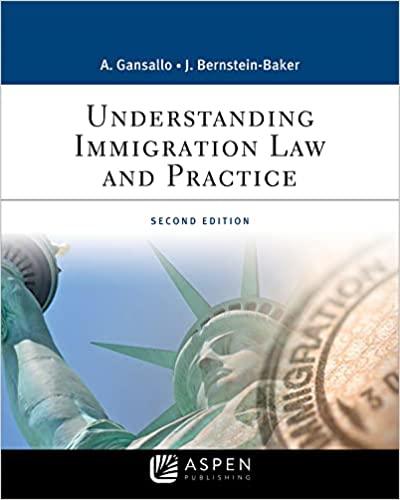Question
Good evening, Can you assist me in formulating a statement of fact, heading, and subheading for the case below? I am having challenges coming up
Good evening,
Can you assist me in formulating a statement of fact, heading, and subheading for the case below? I am having challenges coming up which point to argue first because I know the strongest point should be the opening paragrah.
On the evening of June 6, Gemma Dior, a 25-year-old, was walking down Main Street in downtown Gravestone, Arizona, and came to an intersection near the Gravestone Civic Center. Sid Smith is a driver for GoKar and was driving a GoKar customer to the Gravestone Civic Center. Sid was making conversation with his passenger, and they were talking about baseball teams. The passenger, Darla Davis, was sitting in the back seat of the car and Sid looked back at her to say something. When Sid looked forward, he saw that he was at an intersection and the light had turned red, and he hit the brakes hard, and swerved into the sidewalk area hitting Gemma. Gemma's back, hip, and right leg were injured, requiring a hospital stay, multiple surgeries, as well as physical therapy and recovery time. Gemma sued Sid and GoKar for Sid's negligent driving, stating that GoKar had responsibility for the incident under a theory of respondeat superior.
GoKar disputed that respondeat superior applied, stating that Sid was not an employee. Sid is 42 years old and had been driving with GoKar for a year and a half. He had a clean driving record. GoKar is based in California, but their apps are used in every state. They have several offices in Arizona, including in Gravestone. According to GoKar, their app is simply a way to connect drivers with people needing rides. The GoKar app lets clients identify nearby GoKar driver, see ratings for the drivers, and map where the drivers are. GoKar collects a fee from the clients, not from the drivers. GoKar states that it is really the passengers who hire the drivers, and the GoKar app just makes that process easier. Drivers bear the burden of purchasing and maintaining their own vehicles, as well as auto insurance. Drivers can decide when they want to drive for GoKar and which clients to pick up. The customers pay the driver through the app. GoKar drivers may work for other rideshare companies also. The contract that drivers sign with GoKar states that drivers are "independent contractors" and not employees. GoKar also refers to itself in its advertising and contracts as a technology platform, not as a transportation business.
At the same time, GoKar does retain some control over its drivers. GoKar, not the drivers, sets the fares for rides. GoKar requires its drivers to wear a yellow and black GoKar hat while they are driving for the service. GoKar also demands that drivers place a sign with the GoKar logo in their rear window when they are giving GoKar rides. At the time of the accident, Sid was wearing the GoKar cap. GoKar sets a number of rules for drivers, such as telling them to drive by the route that the GoKar app suggests, and mandating that drivers accept the ride that the GoKar app assigns to them. It is GoKar policy that drivers cannot contact passengers after rides, and regularly sends out guidelines to its drivers suggesting conversations that should be off-limit during rides. When a driver violates any of these rules, they are sent reminders of GoKar policy. GoKar can also prioritize when clients of the app are referred to a particular driver and have seemingly used this practice to give preference to drivers who strictly adhere to GoKar's tips and policies. If GoKar determines that the driver is not following their rules sufficiently, then GoKar may lower the driver's rating. If driver ratings fall below a certain level or if they repeatedly break GoKar rules, then GoKar can decide to ban them from using the app.
***
GoKar's motion for summary judgment is granted. The question of whether a rideshare driver, such as GoKar, is an employee or independent contractor should be decided according to the totality of the circumstances. GoKar drivers have flexibility in their work for GoKar, which is a significant indicator that they are not employees. GoKar cannot be found liable for the negligence of one of its independent contractors.
Gemma's medical bills have come to well over $100,000.
Avery reminds you that different courts have come to different conclusions regarding the question of whether a rideshare driver is an employee or independent contract, and the question is not settled in your jurisdiction. The Ninth Circuit generally holds that the most important factor in determining whether a worker is an employee or independent contractor is the amount of control the putative employer exerts over the worker's position. At the same time, the Ninth Circuit also reviews "the totality of the circumstances" when evaluating whether a person is an independent contractor. Avery mentions that in both California and New York there were administrative rulings by the departments of labor finding that drivers for ridesharing services could be considered employees. Avery says there may be solid policy reasons to argue that GoKar drivers are not employeesGoKar is a highly profitable business, involved in an increasing share of transportation across the country; and if GoKar does not bear some of the burden when their drivers cause accidents, that could be a problem at the policy level.
Step by Step Solution
There are 3 Steps involved in it
Step: 1

Get Instant Access to Expert-Tailored Solutions
See step-by-step solutions with expert insights and AI powered tools for academic success
Step: 2

Step: 3

Ace Your Homework with AI
Get the answers you need in no time with our AI-driven, step-by-step assistance
Get Started


